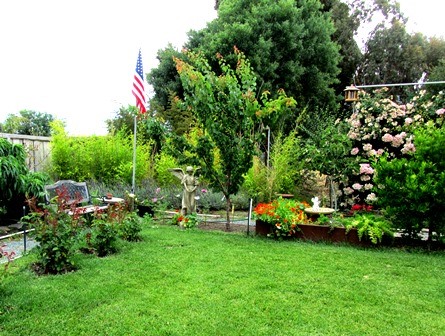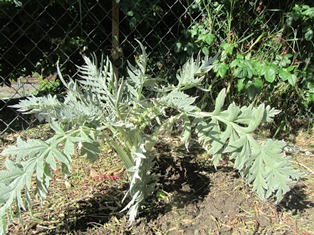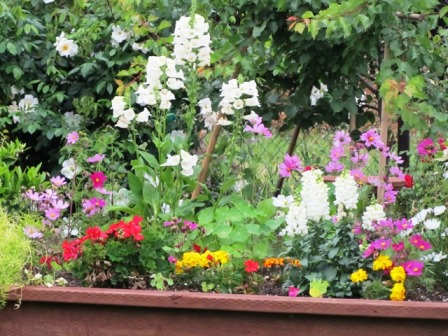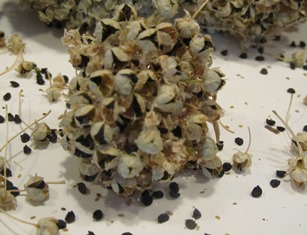Why Seed Saving Matters
Harvesting seed from my favorite flowers and vegetables has become of ritual for me. Basically, the plants do the work. I just pick the dried pods or seed heads, make sure they have an optimal period of time and the right environment to continue drying, and then store and/or share them.

An heirloom rose, a raised box of open-pollinated vegetables or heirloom herbs, or a bed of flowers are easily integrated into this landscape to create a peaceful garden
With access to so many seed sources online and in local nurseries, some might wonder why I would bother collecting and saving seeds from plants I grow. The reasons are simple:
* Many open-pollinated heirloom varieties that I grow once were also grown in gardens generations before my time.
* It’s gratifying to know that through the plants we grow (without pesticides or altered through genetic manipulation), we can have pure and safe food that we grow ourselves.
* Crop diversity can only continue if gardeners and growers are saving seeds of diverse crop varieties.
* Harvesting seeds from what we grow completes the cycle of nature that takes place each year in our gardens.
According to Heirloom Gardener magazine, “Roughly 90 percent of the varieties that existed at the beginning of the 20th Century are extinct.” (Winter 2013-2014) That’s certainly a concern. We can’t bring back those varieties, but we can work together to try to stop further extinctions.
Passing on a garden is a great gift to the next generation. Passing on seeds is equally laudable. Saving seeds matters . . . for all of us who believe in preserving plant diversity.
Salivating Over New Organics from Old and Rare Seed
What I love most about the onset of winter is the arrival of the seed catalogs. Armed with the newest one, I enjoy sitting on the porch, warming my bones under the pale winter sun, and reading about what I could be growing on the Henny Penny Farmette this spring–like the onions from rare, old seed that Bountiful Gardens offers in its 2014 catalog.
Bountiful Gardens is a nonprofit organization located in Willits, California (160 miles north of San Francisco). The organization has signed the Safe Seed Pledge and promises to never knowingly buy or sell seeds that are GMO (genetically modified).
The onion seed I’m eager to purchase is the Mill Creek Red Onion–a special heirloom I read about that is considered to be bolt-resistant and grows well in spring or fall. According to the catalog, the onion was bred by nursery owners Joe and Wanda Turi, who have since passed away. Thanks to the folks at Bountiful Gardens, a box of the Turi’s onions was acquired, ensuring the rare seed would be preserved and multiplied in gardens like mine and yours.
Another vegetable I want to try is the Early Purple Sprouting broccoli, a European heirloom that grows into a large plant with purple heads possessing excellent nutritional value and flavor. An August planting is recommended because the plant needs to survive through a winter to become productive.

I managed not to kill the artichoke I planted last year and, thus encouraged, I would like to grow some other varieties
The artichoke (cynara cardynculus) listing in the catalog also intrigues me. The plant won’t produce chokes during its first year, but I don’t mind. Having an abundance of chokes for farmette meals makes me want to send for the seed right now. Don’t even get me started on all the herbs I want to order and plant! I might have to turn the farmette into a farm.
The Bountiful Gardens 2014 catalog is one of the best. Not only are the listings intriguing to read, the full-color pictures are nothing short of seductive for a gardener. Offerings include heirloom, open-pollinated, untreated seeds for sustainable growing of vegetables, grains, oil and forage crops, wild trees and shrubs, berries, herbs, and flower. The catalog even offers mushroom spawn. There are also books and media products available on gardening topics, composting, permaculture, self-sufficiency, garden pests, tools, seed saving, and much more.
If you are interested in getting your own copy of the 2014 catalog, write to Bountiful Gardens, 18001 Shafer Ranch Road, Willits, CA 95490; phone 707-459-6410. Or email: bountiful@sonic.net. See, http://www.bountifulgardens.org
 Facebook
Facebook Goodreads
Goodreads LinkedIn
LinkedIn Meera Lester
Meera Lester Twitter
Twitter






